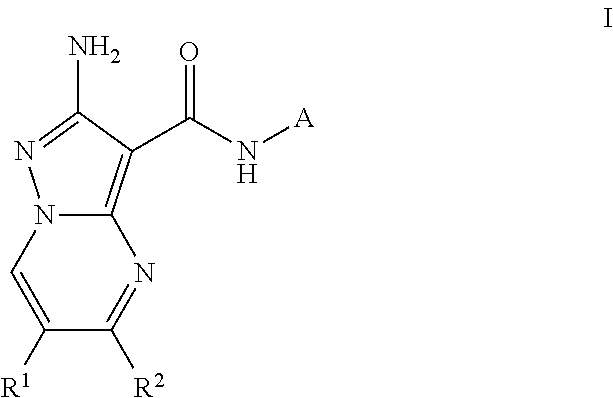Compounds useful as inhibitors of atr kinase
a technology of atr kinase and compounds, which is applied in the direction of drug compositions, transferases, therapy, etc., can solve problems such as dna damag
- Summary
- Abstract
- Description
- Claims
- Application Information
AI Technical Summary
Benefits of technology
Problems solved by technology
Method used
Image
Examples
example 1
(R)-2-amino-6-fluoro-N-(4-((1-methylpiperidin-3-yl)oxy)pyrimidin-5-yl)pyrazolo[1,5-a]pyrimidine-3-carboxamide
[0324]
[0325]A solution of benzotriazol-1-yl 2-amino-6-fluoro-pyrazolo[1,5-a]pyrimidine-3-carboxylate 6a (125 mg, 0.3990 mmol) and 4-[[(3R)-1-methyl-3-piperidyl]oxy]pyrimidin-5-amine 7a (83.10 mg, 0.3990 mmol) in NMP (2 mL) was heated at 100° C. overnight. The reaction mixture was cooled to RT, passed through a SCX cartridge, eluting with 2M ammonia in methanol. The product fractions were combined, concentrated in vacuo and purified by HPLC. The title product I-A-1 was isolated (60 mg., 38.9%)
[0326]The following compounds were prepared according to a methodology similar to the one described in Example 1, starting from the appropriate activated acid 6 a-e and aromatic amine:[0327](S)-2-amino-6-fluoro-N-(4-((1-methylpiperidin-3-yl)oxy)pyrimidin-5-yl)pyrazolo[1,5-a]pyrimidine-3-carboxamide I-A-2;[0328](R)-2-amino-6-fluoro-N-(4-(quinuclidin-3-yloxy)pyrimidin-5-yl)pyrazolo[1,5-a]py...
example 2
N-(4-((4s,6r)-1-azaspiro[3.3]heptan-6-yloxy)pyrimidin-5-yl)-2-amino-6-fluoropyrazolo[1,5-a]pyrimidine-3-carboxamide
[0377]
[0378]A solution of (4s,6r)-tert-butyl 6-((5-aminopyrimidin-4-yl)oxy)-1-azaspiro[3.3]heptane-1-carboxylate (prepared according to a procedure similar to Example 1) (242 mg, 0.7899 mmol) and benzotriazol-1-yl 2-amino-6-fluoro-pyrazolo[1,5-a]pyrimidine-3-carboxylate (247.4 mg, 0.7899 mmol) in NMP (2.5 mL) was heated at 100° C. for 72 h. The reaction mixture was filtered through a SCX cartridge, eluting with a 2M NH3 in MeOH. The appropriate fractions were concentrated in vacuo and the residue was dissolved in DCM (10 mL). TFA (2 mL, 26 mmol) was added and the mixture was stirred at RT for 2 h, then concentrated in vacuo. The residue was purified using preparative HPLC (32 mg, 6.4%).
example 3
2-amino-6-fluoro-N-(3-(4-(4-(oxetan-3-yl)piperazine-1-carbonyl)piperidin-1-yl)pyridin-4-yl)pyrazolo[1,5-a]pyrimidine-3-carboxamide
[0379]
Step 1: 1-(4-(2-amino-6-fluoropyrazolo[1,5-a]pyrimidine-3-carboxamido)pyridin-3-yl)piperidine-4-carboxylic acid
[0380]To a suspension of tert-butyl 1-[4-[(2-amino-6-fluoro-pyrazolo[1,5-a]pyrimidine-3-carbonyl)amino]-3-pyridyl]piperidine-4-carboxylate trifluoroacetic acetate (prepared according to a methodology similar to the one described in Example 1) (101 mg, 0.1773 mmol) in DCM (5 mL) was added TFA (1 mL, 12.98 mmol). The mixture was stirred at room temperature for 20 hours. The solvent was removed in vacuo and the residue azeotroped with DCM (×2) and diethyl ether (×2) to give title compound as a beige solid (98% Yield, di-TFA salt). 1H NMR (500 MHz, DMSO) δ 11.10 (s, 1H), 9.58 (dd, 1H), 8.91 (d, 1H), 8.86 (d, 1H), 8.68 (s, 1H), 8.56 (d, 1H), 6.92 (s, 2H), 3.10 (d, 2H), 2.99-2.82 (m, 2H), 2.53-2.50 (m, 1H), 2.15-1.93 (m, 4H); 19F NMR (471 MHz, DM...
PUM
| Property | Measurement | Unit |
|---|---|---|
| Condensation enthalpy | aaaaa | aaaaa |
Abstract
Description
Claims
Application Information
 Login to View More
Login to View More - R&D
- Intellectual Property
- Life Sciences
- Materials
- Tech Scout
- Unparalleled Data Quality
- Higher Quality Content
- 60% Fewer Hallucinations
Browse by: Latest US Patents, China's latest patents, Technical Efficacy Thesaurus, Application Domain, Technology Topic, Popular Technical Reports.
© 2025 PatSnap. All rights reserved.Legal|Privacy policy|Modern Slavery Act Transparency Statement|Sitemap|About US| Contact US: help@patsnap.com



